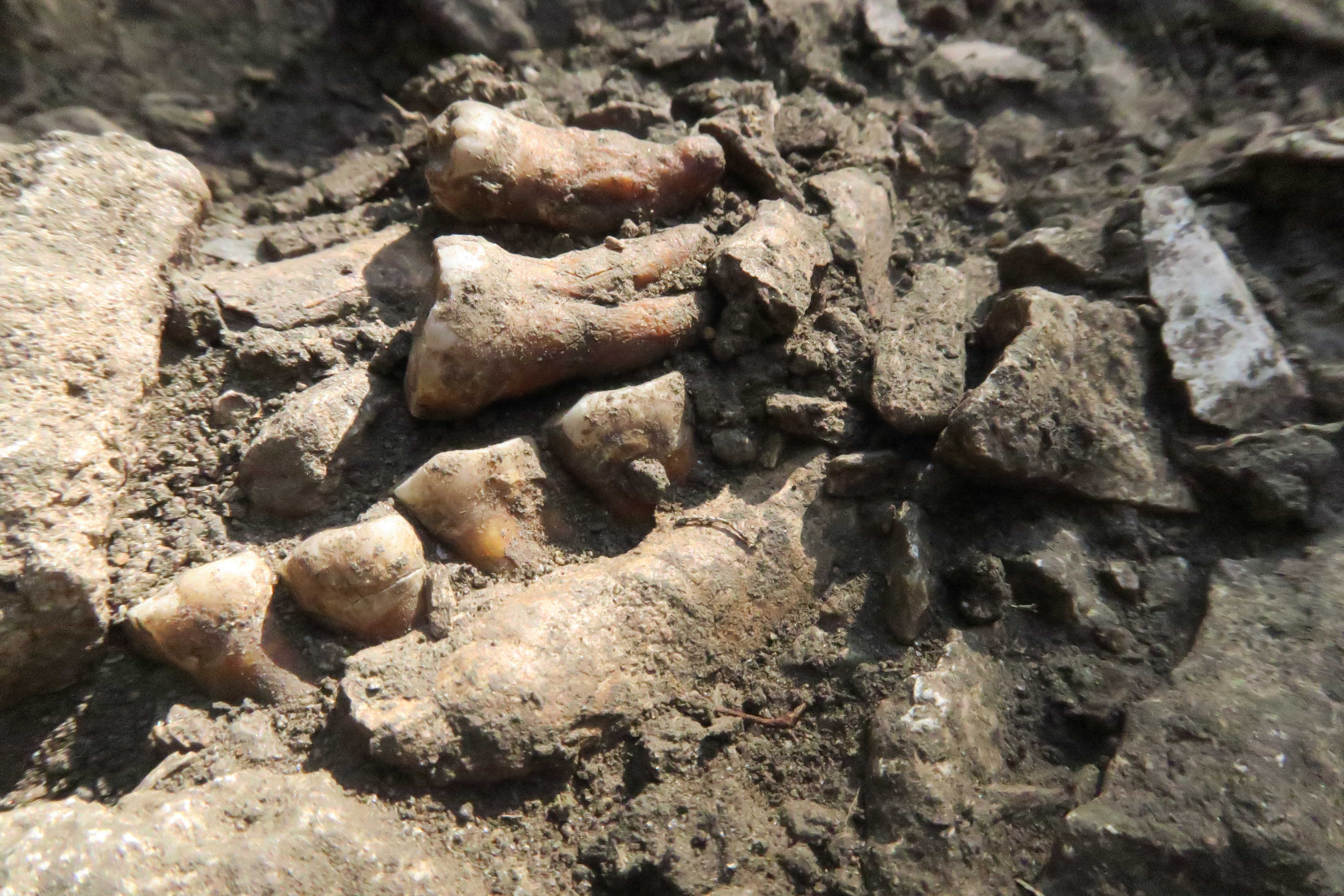DNA
Scientists Warn of an 'Unprecedented Risk' From Synthetic 'Mirror Life,' Built With a Reverse Version of Natural Proteins and Sugars
So-called mirror cells could rampage through our ecosystems, food supply and immune systems, experts say, potentially without existing barriers to protect against them
Geneticists Solve the Mystery of Why Some Cats Are Orange—and Why They Tend to Be Males
Two new, preliminary papers identify a gene related to a cat’s coloration. The work also explains why tortoiseshell and calico cats tend to be females
Scientists Are Trying to Make Whiskey Using Rye Seeds That Were Submerged in a Lake Huron Shipwreck for Nearly 150 Years
Divers, distillers and researchers recently recovered grain from the "James R. Bentley," a wooden schooner that sank during a storm in 1878
Fat Cells Retain a 'Memory' of Obesity, Making It Hard to Lose Weight and Keep It Off, Study Suggests
Obesity leads to DNA alterations that affect gene activity and linger after weight loss, a finding that researchers say could help reduce stigma around the disease
DNA Evidence Is Rewriting the Stories of Victims Who Perished in Pompeii Nearly 2,000 Years Ago
A new study has shattered historians' long-held assumptions about some of the people who died in Mount Vesuvius' eruption in 79 C.E.
Archaeologists Are Bewildered by a Skeleton Made From the Bones of at Least Eight People Who Died Thousands of Years Apart
Found in a cremation cemetery in Belgium, the skeleton includes bones dating to the Neolithic period and a Roman-era skull, according to a new study
Scientists Think a Skeleton Found in a Well Is the Same Man Described in an 800-Year-Old Norse Text
The remains were discovered during excavations in 1938. Now, researchers have learned new information about his identity by analyzing DNA from his tooth
A 110-Year-Old Pickled Thylacine Head Helped Build the Most Complete Ancient Genome to Date, Says 'De-Extinction' Company
Colossal Biosciences reports it extracted DNA and RNA from the Tasmanian tiger specimen, a key step forward in its effort to create a modern proxy of the extinct species. Other scientists are calling for data to back up the claim
Can't Get Enough Carbs? That Craving Might Have Started More Than 800,000 Years Ago
New research traces the genetic underpinnings of the enzyme amylase, which helps humans digest starches and sugars
Two Lions Went on a Man-Eating Spree in 1898. Now, DNA Evidence Reveals Their Diets
The notorious predators, nicknamed the “Man-Eaters of Tsavo,” terrorized railway workers in Kenya for roughly nine months
Scientists' Work on Protein Structure, Which Governs All Aspects of Life, Wins Nobel Prize in Chemistry
David Baker, Demis Hassabis and John M. Jumper revealed how amino acids shape protein structure, a finding that could aid in drug discovery
American Scientists Win Nobel Prize in Medicine for 'Groundbreaking' Gene Discovery Made by Studying Worms
Victor Ambros and Gary Ruvkun discovered microRNA, tiny molecules that play a crucial role in how cells develop, paving the way for new treatments for diseases
DNA Reveals Identity of Officer on the Lost Franklin Expedition—and His Remains Show Signs of Cannibalism
Researchers recently identified James Fitzjames, a captain on the ill-fated HMS Erebus that went looking for the Northwest Passage in 1845
In Case Humans Go Extinct, This Memory Crystal Will Store Our Genome for Billions of Years
Scientists have created "a form of information immortality" meant to instruct future species on how to recreate humans. But who, or what, will find it?
Easter Island's Ancient Population Never Faced Ecological Collapse, Suggests Another Study
New DNA analysis adds to growing research indicating the famous Pacific island did not collapse from overuse of resources before the arrival of Europeans
Ancient DNA Reveals Neanderthal Group Was Isolated for 50,000 Years
A new study, based on the remains of a Neanderthal nicknamed Thorin, is shaking up what archaeologists long thought about these early humans in Europe
Scientists Identify the Gene Behind Thorny Roses and Other Prickly Plants
A recent study could pave the way to cultivating various thornless plants, making them easier to grow and potentially more widely available
Archaeologists Uncover the Real Story of How England Became England
New research is revealing how the Sceptered Isle transformed from a Roman backwater to a mighty country of its own
Inside the Hidden Kingdom of Viruses in Your Gut
Human innards are teeming with viruses that infect bacteria. Here's what scientists are learning about them
Archaeologists May Have Identified the Bones of a Celebrated Ninth-Century Bishop in Spain
Bishop Teodomiro was a central figure in the creation of the Camino de Santiago pilgrimage
Page 1 of 22
:focal(2850x1900:2851x1901)/https://tf-cmsv2-smithsonianmag-media.s3.amazonaws.com/filer_public/48/cd/48cd8c49-1f65-489c-909c-2d128448d16a/gettyimages-1703790414.jpg)
:focal(2736x1733:2737x1734)/https://tf-cmsv2-smithsonianmag-media.s3.amazonaws.com/filer_public/8c/67/8c67a0ce-babb-4d7d-97c3-dd4abcfcc51c/gettyimages-1190651900.jpg)
:focal(650x365:651x366)/https://tf-cmsv2-smithsonianmag-media.s3.amazonaws.com/filer_public/05/21/0521ce72-be87-4ae8-82e1-497c1dbf4d41/jonah-brown_dsc07779.jpg)
:focal(2422x2053:2423x2054)/https://tf-cmsv2-smithsonianmag-media.s3.amazonaws.com/filer_public/b0/84/b0842710-0364-4fea-af8f-d9b2ebb10697/gettyimages-549602961.jpg)
:focal(848x638:849x639)/https://tf-cmsv2-smithsonianmag-media.s3.amazonaws.com/filer_public/15/b6/15b62b35-b360-4b81-8019-ef6aed2fece2/original_1.jpeg)
:focal(792x543:793x544)/https://tf-cmsv2-smithsonianmag-media.s3.amazonaws.com/filer_public/a4/26/a426c7fb-e4cc-499d-81a3-de0eb2923e37/urn_cambridgeorg_id_binary-alt_20241019094932-63883-optimisedimage-png-s0003598x24001583_fig2.jpeg)
:focal(450x338:451x339)/https://tf-cmsv2-smithsonianmag-media.s3.amazonaws.com/filer_public/8c/09/8c09444b-5a9b-424a-b5bf-4e47be6742ad/gr1_lrg.jpeg)
:focal(191x115:192x116)/https://tf-cmsv2-smithsonianmag-media.s3.amazonaws.com/filer_public/4d/68/4d68d031-9cdf-425a-a66e-32d1834b07db/thylacinus_cynocephalus_2_gould.jpg)
:focal(960x640:961x641)/https://tf-cmsv2-smithsonianmag-media.s3.amazonaws.com/filer_public/9e/59/9e592cb6-c1d1-4bb4-ae6e-d9bacbff09b4/bread-8503298_1920.jpg)
:focal(351x234:352x235)/https://tf-cmsv2-smithsonianmag-media.s3.amazonaws.com/filer_public/fc/91/fc912dea-5c42-4fd3-90b5-1b9d2081134f/lionsoftsavo2008.jpg)
:focal(2138x1609:2139x1610)/https://tf-cmsv2-smithsonianmag-media.s3.amazonaws.com/filer_public/58/7b/587babef-0a51-42f8-96fc-a7f6ca244779/gettyimages-2176888624.jpg)
:focal(3402x2268:3403x2269)/https://tf-cmsv2-smithsonianmag-media.s3.amazonaws.com/filer_public/27/85/278532d8-0090-42d6-9ff6-77449b49da84/gettyimages-2176426457.jpg)
:focal(700x527:701x528)/https://tf-cmsv2-smithsonianmag-media.s3.amazonaws.com/filer_public/a7/ae/a7ae73c6-3b99-40ee-8f77-2bfd6e4366dd/smithmag-photograph-1400px-v1.jpg)
:focal(1024x575:1025x576)/https://tf-cmsv2-smithsonianmag-media.s3.amazonaws.com/filer_public/5a/e2/5ae236c1-dbe7-48a0-9b08-03e71a9e2590/skynews-genome-5d-crystal_6689808.jpg)
:focal(1200x800:1201x801)/https://tf-cmsv2-smithsonianmag-media.s3.amazonaws.com/filer_public/58/d8/58d86da0-cbee-4298-9a13-039bea8d2ae3/thomas-griggs-anvaqssbtms-unsplash.jpg)

:focal(2128x1419:2129x1420)/https://tf-cmsv2-smithsonianmag-media.s3.amazonaws.com/filer_public/25/28/2528f427-5b55-4e98-b85e-5f9523b4fc9a/gettyimages-157567545.jpg)
:focal(922x615:923x616)/https://tf-cmsv2-smithsonianmag-media.s3.amazonaws.com/filer_public/c7/e2/c7e2d0ca-8dd1-461e-a4d4-7abd693e6695/sepoct2024_l08_prologue.jpg)
:focal(800x602:801x603)/https://tf-cmsv2-smithsonianmag-media.s3.amazonaws.com/filer_public/46/02/46026cf0-fbc2-4552-aa5c-fb19a8430429/gettyimages-1333712258_web.jpg)
:focal(587x441:588x442)/https://tf-cmsv2-smithsonianmag-media.s3.amazonaws.com/filer_public/0c/f8/0cf813ef-9e3c-41ef-ba89-dec6d504837e/urn_cambridgeorg_id_binary-alt_20240805235708-82096-optimisedimage-png-s0003598x24000917_fig6.jpeg)